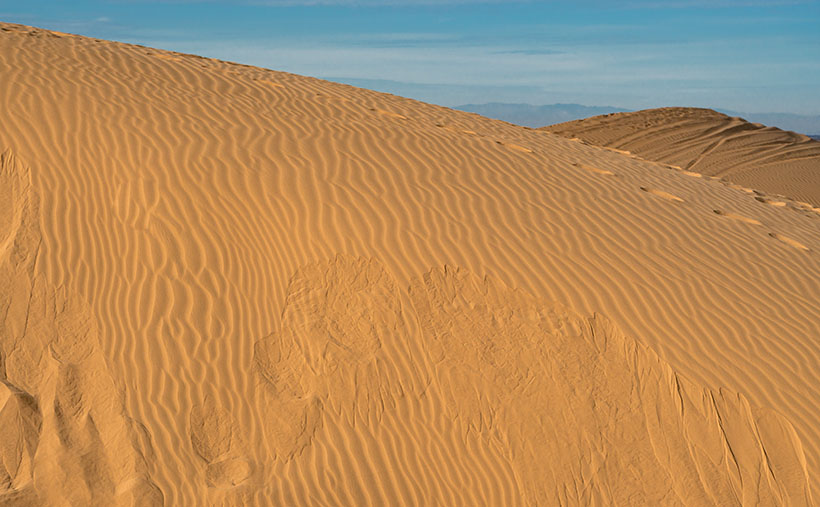
My sisters and I never got to play in sandboxes when we were toddlers. My dad said it was because the cats kept covering us (cue drum). That joke was the extent of my dune knowledge until this month’s project. It turns out that they’re pretty complex.
For example, I thought they were a large pile of uniform sand grains. Not so. Only the grains on the surface layer are the same. Below—about a yard (or a meter, if you’re Canadian)—is another layer where the sand grains are large enough that wind can’t lift them. The surface has even more refined grains that get picked up and suspended in the air—like dust—and carried to faraway places. Recently, scientists found that dust from the Sahara Desert is held aloft high in the trade winds and falls back to earth in the Amazon Rain Forest. The settling dust is the source of nutrients supporting jungle plants. The soil in that area of Brazil is otherwise nutrient-poor because the river constantly flushes everything out to sea.
The weirdest fact that I learned was that dunes could sing—not like in tunes from Rocky Horror Picture Show—but a deep booming bass note (70-100 Hz). Conditions have to be perfect. The sand must be dried (in the hot summer), it must be windy, and the dunes must be tall—120 ft or more. The Algodones Dune field is not that high, but the Dumas Dunes between Barstow and Las Vegas are, so now I have to hear this for myself.
Here’s how it works. As wind moves over the field, the windward face of the dune forces air up and move faster—like an airplane wing. The fast-moving air picks up sand from the middle of the face and drops the sand at the top. When the angle of the top sand exceeds 35 to 38 degrees, it’s not able to support its weight, and it begins to slide down the dune’s leeward face—as we see in this week’s image called Dune Avalanche, but on a larger scale. As the sand slides, it creates vibrations reflected off the denser layer beneath—like the strings and body of a cello work together to make music. If you’d want a more thorough explanation from a more credible source, you can watch What Makes These Dunes Sing? (ft. @It’s Okay To Be Smart) on YouTube, but be warned, you need a good bass response from your speakers, or you won’t hear the song. And you thought last week’s story about the sandworms was fantastical.
I took this week’s picture at the Imperial Dunes Recreation Area, as you can guess by the tire tracks in the background. When I saw the sloughing sand, I knew that it was essential to the ecology of the dunes, but I didn’t appreciate why. After this week’s research, I’m glad that I snapped the photo, and—as I said above—I want to check out the Dumas Dunes and maybe go back to Death Valley. I want to hear their song—but do I want it bad enough to go when it’s 120 degrees?
You can see a larger version of Dune Avalanche on its Web Page by clicking here. Next week we’ll poke more into the beauty of the Algodones Dune Field, so come back then.
Until next time — jw

I saw an article recently (but did not read it all) that talked about scientists studying the ‘wavelength’ of those ripples on the face of the dune. There is a physics to them that they want to figure out.
Don
In the video that I recommended in the post, they touch on that subject too. – jw
Dunes sing, who knew?
You always have been interested in music!
No maybe not at 120 degrees!!!